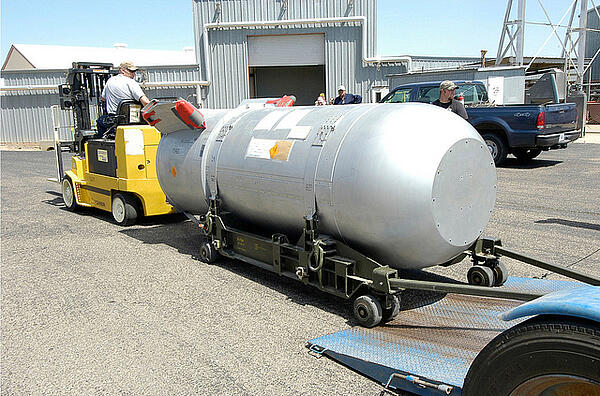B53 Bomb
It was not until October 2011 that the US finally dismantled the last B53 bomb. Originally called the MK 53, the B53 was produced from 1961-1965. Around 340 bombs were manufactured. The B53 was in service from 1962 to 1997, when it was retired.
With a blast yield of nine megatons, the B53 was one of the most powerful nuclear bombs ever built. Its shockwaves were so powerful that they could reportedly kill people sheltering in underground shelters. This meant that even the controllers of the Soviet nuclear programme in the USSR operating underground were not safe.
600 times more powerful than the ‘Little Boy’ which was dropped over Hiroshima at the end of World War Two, the B53 had the potential of causing unimaginable damage. The B53 was made during the Cold War’s most dangerous time: the Cuban Missile Crisis of 1962. The number of bombs produced numbered 340 by the time production ended in 1965.

Weighing 8,850 lbs and spanning 12 feet and four inches, the B-52 was around the size of a large car and was mainly transported by B-52 bombers. The B53 was built to be bigger and better than the USSR’s ‘Tsar’ bomb, which was described as the ‘king of bombs’. Although the ‘Tsar’ bomb had the biggest blast, but the weight and size of the bomb limited its range and speed.
When detonated, the B53 could have produced a fireball of nearly three miles in diameter. Anybody within 18 miles of the blast’s epicentre was expected to be killed by the intense heat created by the blast. Most buildings within 10 miles of the blast would have been destroyed. However, the B53 was primarily designed as a ‘bunker buster’ to destroy the deep underground bunkers where Soviet Union commanders were thought to operate. The bomb had the potential to destroy everything remotely near it, leaving a smoldering crater. This was the U.S. plan for “victory” in a nuclear war right up until the implosion of the Soviet Empire.
The B53 nuclear bomb was a two-stage implosion weapon using highly enriched uranium and 95 per cent enriched Lithium-6 deuteride fusion fuel. It was produced in two versions including B53-Y1 and B53-Y2. The nuclear weapon was designed to be air dropped using five parachutes, while the free fall delivery was also possible by jettisoning the "can" with the parachutes.
The B53 was initially supposed to be retired in the 1980s, but 50 units remained in the active stockpile until the deployment of the B61-11 in 1997.The B53s were set for immediate disassembly, but the process was slowed down by safety concerns. It was not until 2011 that the final bomb was dismantled.
See also:
MLA Citation/Reference
"B53 Bomb". HistoryLearning.com. 2025. Web.
